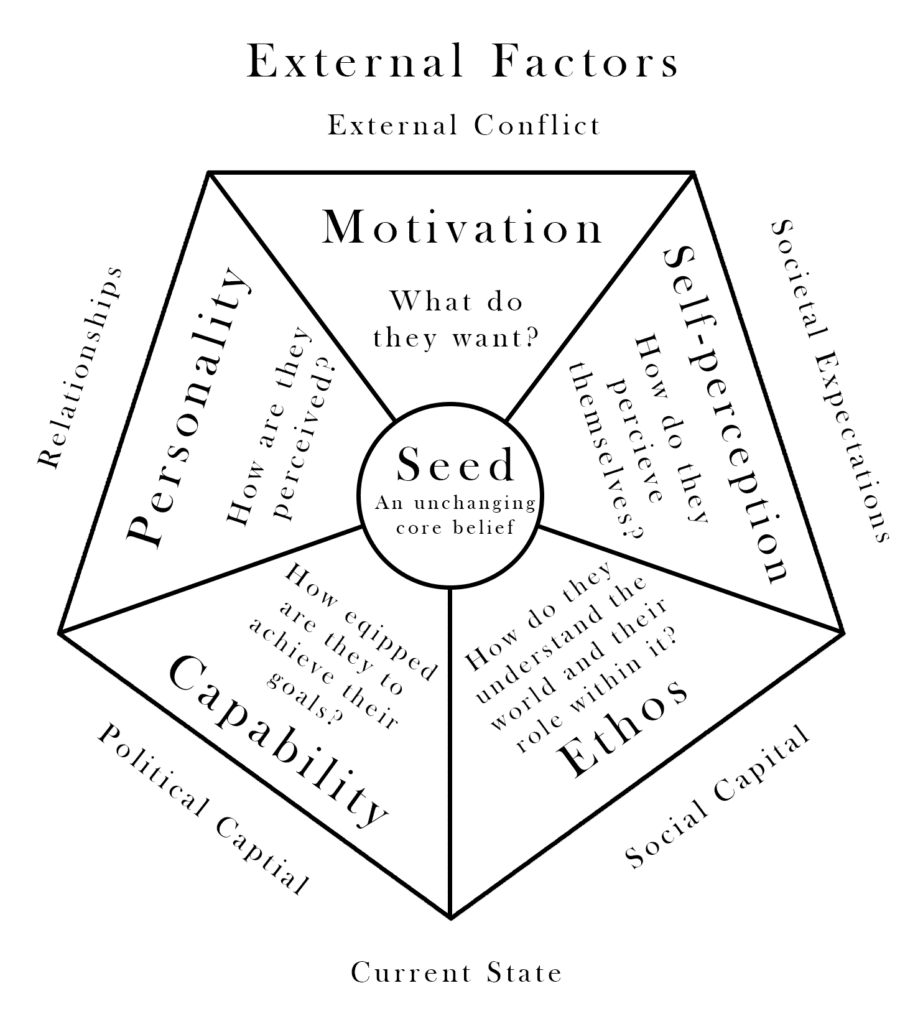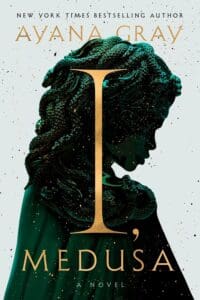The Seed of a Character
When I began as a fiction writer, I had no idea how to create a character. My method was trial and error with an emphasis on the error. Eventually, I stumbled on to characters who I felt were authentic, fleshed-out people, but I couldn’t tell you how I got there.
I looked for ideas online to improve my process and found lists of questions about a character’s physical descriptions, relationships, history, weaknesses, interests, personality traits, communication styles, etc. There were over 100 questions on these forms for each character, and none of it helped me understand the person I was writing any better. It was helpful to document their brown eyes for continuity, but that didn’t define them.
The goal was to create authentic characters not lists of traits.
Listening to Brandon Sanderson’s lecture series (highly recommended viewing) helped me hone in on the fundamental core of a character. Sanderson broke down characters by values, motivation, personality, and quirks. He went further to place them on a set of three spectrums: Proactivity, Relatability, and Capability.
While his ideas helped me conceptualize a process of building a character, I felt like there were things missing from the framework. I had a difficult time putting my finger on it until I read The Green Bone Saga, by Fonda Lee, specifically the character Hilo.
Warning: there will be extremely mild spoilers for The Green Bone Saga here. Look for the next bold line to skip the mild spoilers.
*
*
*
When we met Hilo, he was the Horn of the No Peak clan, one of the two key advisors for the leader of the clan and the head of the enforcement arm of the organization. He was a brash, bull-headed traditionalist who loved his family more than anything and thought he could fight his way through every problem.
Over the course of the books, Hilo’s biases about women, people who can’t use jade, and LGBTQ folks changed and adapted. His political awareness and ability for nuance grew. He learned ways to settle conflict without his first thought being violence. These changes didn’t come out of nowhere. They didn’t make Hilo unrecognizable. They all sprang from the core of his character, his belief that family was the most important thing in life.
The part of Hilo that believed family was everything never changed. It was who Hilo was. So when many of the details about how he moved through the world changed, he was still recognizable. He was the same person at his core, and the changes felt earned because each change was directly related to that unchanging seed in the middle of his character.
*
*
*
End of mild Green Bone Saga Spoilers
When I looked at my own characters, the idea that each of them had an unchanging core belief that defined them helped me better understand who I was writing.
Kaylo, the main character of my Malitu books, took responsibility for the world around him, and he couldn’t help it. He blamed himself for tragedies. He forced himself to be a leader when he had no desire to be one. He upended his life for a stranger because he couldn’t stop taking responsibility.
I started incorporating this idea of a character’s seed into my writing. As I began outlining and worldbuilding for my next series, I took it a step further and created a model for understanding my characters.
The Seed Model
Before I get into the model, as with any piece of writing advice, don’t take it if it doesn’t help. This is a model that works for me. It is very new and untested. I have no authority to claim there is a right way to create characters. In my opinion, there are an infinite number of ways to go about creating characters, and they each have their uses.
Secondly, there are elements of my model that are reflected in various other models. Those other models are just as valid. It all depends on what works for you.
Now that that is out of the way, here is The Seed Model.

At the center of the pentagon is the seed. It is the focus of this character creation model and everything inside the pentagon is a reflection of the character’s seed. I define the seed as an unchanging core belief.
This should be something simplistic and internal to the character. Meaning, the seed should not be about another character. It can be about the importance of love, family, or relationships, but individual relationships change with time and circumstances. This seed should remain in place, even if character relationships change.
A seed might be a longing for power, a character’s belief that they are meant for something great, a commitment to justice, or a desire to be of use.
From one simple idea, the character grows.
I have broken down the internal characterization into 5 categories: Motivation, Personality, Self-Perception, Capability, and Ethos. All will be a reflection of the character’s seed, even as some of them will change throughout your story.
I want to make a note: when I say reflection, I do not mean these categories are always in alignment with a character’s seed. For instance, an antagonist might long for power at their core, but build their personality to hide that truth.
The Five Categories
Unlike the seed, these five categories are largely where we see progression and changes within characters. Over the course of a story and a series, a character is going to change in several of these categories. It all depends on the type of character arc they will experience.
What I am proposing in this model is that even when a character changes in one of these categories, their motivation/personality/self-perception/capabilities/ethos will continue to be an extension of their seed. That tether between who they become and who they were creates an arc rather than an altogether different person.
Motivation – What does the character want?
This is the goal or set of goals that drive this character’s action. It is an outward extension of the character’s seed. It changes with time, circumstance, and progress.
Personality – How are they perceived?
These are the mannerisms, quirks, and behavioral patterns that the character exhibits. These change, but only with difficulty. These changes often show outward growth or decay in how a character interacts with the world around them.
Personality is largely affected by a character’s self-perception. It can be an honest reflection
or a dishonest reflection of self-perception.
Self-Perception – How do they perceive themselves?
This dictates the tone of a character’s inner voice. When in this character’s POV the audience is able to witness how this character treats themselves and thinks about themselves. This is often a reflection of whether the character is in alignment with their seed.
Capability – Are they equipped to achieve their goals?
This is the measure of the character’s skillset versus the task they are set against. It may include magic, intelligence, physical combat ability, resilience, and a range of other skills.
Ethos – How do they understand the world and their role within it?
This dictates the rules a character imposes upon themselves. It is often in service of their seed. It creates limits to the means that a character is willing to pursue to achieve their goals.
Outside the Pentagon
Every character has a variety of external influences that affect their internal characterization. I identified six that stuck out to me as especially salient, but there are countless others.
External Conflict – What obstacles are in the way of this character reaching their goals?
Relationships – Who is the character connected to?
Societal Expectations – How do the communities around this character expect them to behave, especially those with power to enforce their expectations?
Political Capital – What amount of control does this character have over the resources and workings of their society?
Social Capital – How well connected is this character with the people in their community? Are they able influence others or leverage their communities to help them achieve their goals?
Current State – What are the current circumstances/status quo of the world around the character?
Final Thoughts
I could ramble on for far too long about what I believe goes into creating authentic characters, and maybe I already have.
Let me end by saying that this tool isn’t meant to be static. When I am writing characters, I often learn things about them that contradict or are out of tune with what I once thought. During my writing process, I might discover that I have misidentified a character’s “unchanging core belief”. However, if that happens, I need to reevaluate the other aspects of the character and assure they are in alignment and consistent, especially over the course of a series.
One of the most fundamental parts of creating an authentic character is that they are consistent. They should change and grow throughout a story, but they always need a tether of consistency or else it reads like the character has been replaced.
If any part of this framework is helpful for you, please feel free to use it. If it feels completely ridiculous, ridicule me to your heart’s content in your discord groups. If it seems obvious, redundant, and a complete waste of the time you spent reading, I apologize.
Good luck creating wonderfully complex characters.
About the Author

James is a nerd with a head full of stories and limited time to put them on the page.
He grew up in Grand Rapids, MI, spending an excessive amount of time at a local community theater where he developed his affinity for storytelling. This affinity grew into a deep admiration for language and spoken word poetry while studying mathematics and education at the University of Michigan. A few hundred mediocre poems and lackluster performances later, he decided his dream of writing a novel might not be as ridiculous as he once thought. He firmly believes that art—even silly books about magic, or maybe especially silly books about magic—has the ability to tell stories that sink beneath the surface.
Author website: https://www.jamesdulin.com/
Twitter – https://twitter.com/JamesLDulin
Instagram – https://www.instagram.com/jameslloyd27/
TikTok – https://www.tiktok.com/@jamesldulin




Leave a Reply